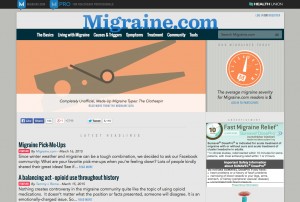People actively involved in their health and healthcare generally have better outcomes in managing their condition. So how do those of us working in healthcare and healthcare marketing motivate people to get more involved? While we don’t have all the answers, Health Union has learned some valuable lessons and practical tips for enhancing patient engagement since launching our first platform, www.Migraine.com, more than four years ago. Here, we share some key insights from our recipe for cultivating active, engaged patient communities, and hopefully, help marketers avoid common pitfalls.
1. Listen to patient communities
Our mantra – the community is always right! Observe patterns of engagement to learn what interests patients and what doesn’t. Success will come from aligning your agenda to respond to their needs, which will continue to evolve over time. For instance, early in the lifecycle of our RheumatoidArthritis.net community, Health Union created a series of yoga videos that could help patients with rheumatoid arthritis increase strength and flexibility. Unfortunately, we offered a great solution to a problem that our current members weren’t interested in fixing. However, as our RA community continued to grow – and interests became more diverse – these yoga videos eventually became relevant to a certain segment of the community. Engagement often depends on offering the right content at the right time, and it’s important to continually assess the needs of patients as your audience grows.
2. Segment based on behaviors, not demographics
In our communities, we observe similar behavior patterns at various phases throughout the patient journey. For example, in people with type 2 diabetes, we recognized that patients who were newly diagnosed, adding a new medication, or lapsed treaters were all relating to tips-and-tricks-type of problem solution articles. So, we created a profile for these “frustrated quick-fixers” and developed a strategy to develop this type of content on many different topics. Once you recognize a behavior segment, seek to understand what’s driving those behaviors and find multiple ways to meet the true underlying needs.
3. Meet people where they are
Make it simple for people to engage, regardless of how much time, knowledge, or interest they have. The easier it is for people to engage, the more likely they are to do it, and keep doing it! While this seems obvious, it is important to keep in mind that what is easy for one person, may not be easy for another. Provide multiple, unique, and easy opportunities for people to participate where they are and according to their comfort level. We often initiate engagement on Facebook (without requiring a site visit) since patients are already there and willing to participate with a like, share, or comment. On our websites, anonymous polls enable “lurkers” to participate. We also build content to meet the needs of different types of community members. While some content is simple, basic information that can quickly answer commonly asked questions, other content is more detailed with higher-level scientific data.
4. Validate concerns or challenges first, and then offer solutions
Most people know what they should do to improve their health, but they don’t take action, for many reasons. Choosing healthy behavior is difficult. We’ve learned that we can increase engagement and empower our community members when we acknowledge and validate the challenges of making health improvements before offering solutions.
Many people with migraines become frustrated when encouraged to exercise by their healthcare providers. For some, exercise can trigger a migraine attack; for others, migraine is chronic and getting out of bed is exhausting in itself. Exercise tips and advice are often met with negative reactions among the migraine community. However, when we acknowledge that exercise can be a challenge for people with migraine and offer varying ways to increase physical activity while managing potential migraine triggers, we create a positive connection and encourage healthier behavior.
5. Align interests and opportunities
Once you learn what interests and motivates your audiences, provide more opportunities for them to get involved. Use past performance to guide strategy. Experiment with variations on proven areas of interest to create new ways to engage. For instance, we received an overwhelming response to our annual Migraine In America survey, making it clear that people with migraines are seeking opportunities to be heard, share their opinions, and compare experiences. As a result, we started building more feedback mechanisms into our communities – from quick polls and questions for our Facebook community to creating specific opportunities for patients to opt-in for survey invitations from corporate and academic partners.
While there are many ways to create and maintain patient engagement, these principles are some of the most critical for success.
Editor’s Note: This is the first installment in a two-part series from Health Union. Check out our April issue of DTC in Focus to read about making engagement a habit and how these principles apply to adherence and patient support.



